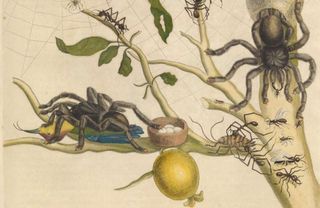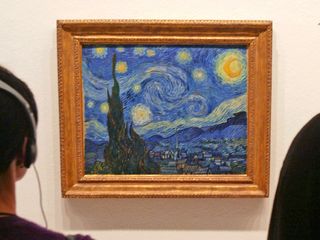Gallery: 5 Times Science Inspired Art
The Scream

Edvard Munch painted the iconic composition "The Scream" in 1893 after writing in his diary that he was inspired by a roiling, blood-red sky he saw one night while walking with friends in Norway. The striking atmosphere and the fact that Munch said he was inspired by a real sunset has led to multiple theories about what caused the sky to look so tumultuous that fateful evening.
One popular hypothesis is that Munch was seeing the aftereffects of the 1883 eruption of Mount Krakatoa in Indonesia, which threw so many aerosol particles in the air that it cooled the entire planet — and created brilliant sunsets as light reflected off the particulate matter. A newer theory suggests that Munch was inspired by rare nacreous clouds, which create a wavy, mother-of-pearl effect visible only at sunrise and sunset, particularly in the winter at high latitude.
Science illustration as art

Maria Sibylla Merian saw things other people didn't. In 1705, the German artist and naturalist sketched a tarantula eating a hummingbird, a drawing that would eventually give a whole genus of spiders their name ("birdeaters"). Although the original engraving was criticized as pure fantasy, birdeater tarantulas do sometimes eat birds. Many of Merian's most striking works of art came from her two years on a scientific expedition to Suriname from 1699 to 1701. She documented insect metamorphosis in detail never seen before, and her vivid depictions of animal life are still sought after today.
Volcanic sunsets

Munch may or may not have been inspired by a volcano-boosted sunset, but other artists probably were.
For instance, scientists studied the landscape paintings of the Romanticist artist Joseph Mallord William Turner (better known as J.M.W. Turner). Turner is famous for his nature-inspired works that depict tempestuous seas, moonlight scenes and mountain vistas. According to that study, published in 2014 in the journal Atmospheric Chemistry and Physics, Turner painted spectacular sunsets in 1816 in England that were caused by particulate matter from the 1815 eruption of Mount Tambora, one of the strongest volcanic eruptions ever. The cooling effect of all the volcanic ejecta in the atmosphere created the "Year Without a Summer," which led to crop failures and food shortages in North America and western Europe.
The Year Without a Summer may also have inspired Mary Shelley to write Frankenstein: She and her writer husband Percy Bysshe Shelley and their friend Lord Byron were trapped inside for days due to cold, wet weather while on vacation in Switzerland that summer and decided to have a horror-writing competition to pass the time.
Microbe masterpieces

Bacteria and yeast become paint and agar gel becomes the canvas in the American Society for Microbiology's annual Agar Art contest. Each year, microbiologists with the creativity bug make masterpieces inside Petri dishes, like this one by Mehmet Berkmen and Maria Penil entitled "Neurons." Winners tend to be science-themed — in 2016, first place went to a depiction of sperm fertilizing an egg, made mostly with Staphylococcus bacteria. "Neurons" took the top prize in 2015, just edging out a map of New York City made of microbes and a yeasty representation of a farmhouse in harvest season.
Starry, turbulent night

Vincent van Gogh's "The Starry Night" may seem fanciful, with its swirling stars and complex brushstrokes. In 2006, though, physicists from the National Autonomous University in Mexico got curious about those swirls and plotted them as if they were real. What they found, reported Nature, was that van Gogh accurately depicted turbulent flow — on a mathematical level.
This amazing physics insight appeared not only in 1889's "The Starry Night," the researchers found, but also in other paintings made when van Gogh was struggling with psychotic episodes and other mental health problems. (The artist was in a mental institution when he painted "The Starry Night.") Two paintings made shortly before van Gogh committed suicide in 1890, "Road with Cypress and Star" and "Wheatfield with Crows," depict the same, remarkably accurate, turbulence, they found.
Editor's Note: This story was updated to note that Van Gogh committed suicide in 1890, not 1990.
Sign up for the Live Science daily newsletter now
Get the world’s most fascinating discoveries delivered straight to your inbox.

Stephanie Pappas is a contributing writer for Live Science, covering topics ranging from geoscience to archaeology to the human brain and behavior. She was previously a senior writer for Live Science but is now a freelancer based in Denver, Colorado, and regularly contributes to Scientific American and The Monitor, the monthly magazine of the American Psychological Association. Stephanie received a bachelor's degree in psychology from the University of South Carolina and a graduate certificate in science communication from the University of California, Santa Cruz.
